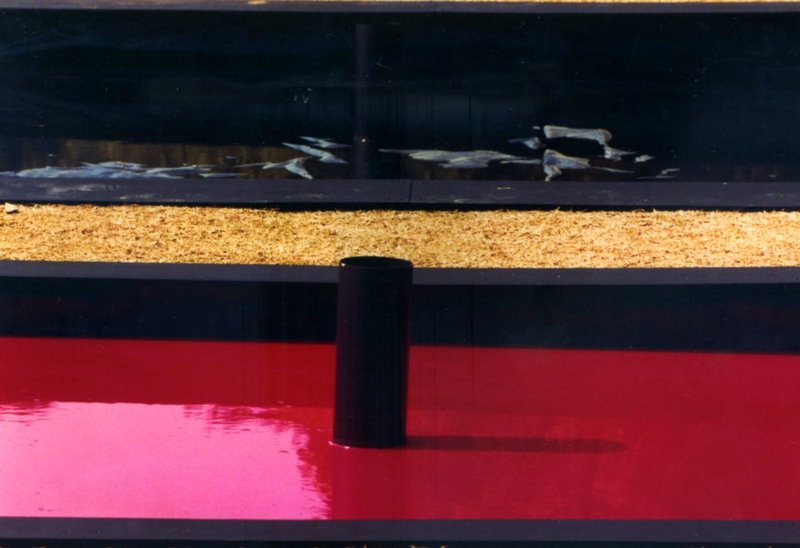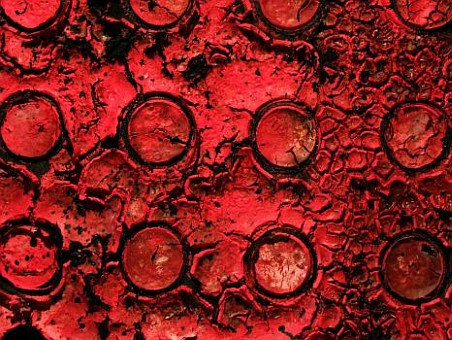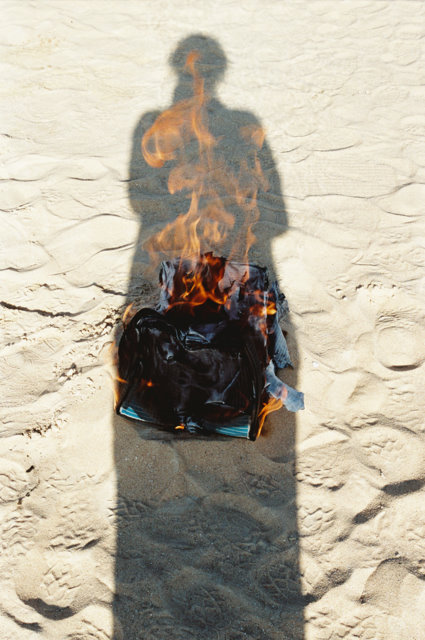MarK Gisbourne
GABRIELE HEIDECKER: AN ESSAY IN RED AND BLACK
"Fire is then the perpetual antagonist of gravity, far from being subject to it; thus everything in nature is in a perpetual oscillation of expansion and contraction through the action of Fire upon bodies and through the reaction of the bodies, which oppose the reaction of fire through the weight of their cohesion and parts.....To insist that fire has weight is to destroy nature; indeed it removes from nature its most essential property, that which makes it one of the main instruments of the Creator." 1

An essay of enquiry into red and black has to suppose the distinctive contraries of life and death. The sanguine passion that is life, and the blackness of melancholy that suggests the conditions of life deferred.2 To speak of the alchemy of fire is to speak of the archaic and the elemental,3 but to describe the colour red is to express the immediacy of life and sensation.4
Thus in the juxtaposition of red and black we are presented with strange contraries that in their different ways reinforce the conditions of organic life in the world. For the artist Gabriele Heidecker whether it is in photography, paintings or installations, there is a great awareness of general entropy in all that she creates and does. This artist well knows that that which lives must die to create new life, and that in its dying it will have the power to regenerate life anew. And, like the iconic wheel of India, Heidecker intuits and feels she knows that there is a seemingly profound circularity to organic life. The world of reality for Heidecker is in a perpetual state of creation and dissolution, pain and ecstasy, continuity and discontinuity. There is a light in the darkness of the night, just as obviously as there are darkness and/or shadows in the light of the day. Hence in purely symbolic terms red and black have an inseparable and unquestionable mutuality as regards our vital experience of human life; that which is ‘vital' being the engine of a lived vitality.
Equally the material practices of art have always both in the East and West possessed this same mutuality, just as the black embers of the fire create the charcoal with which artists can draw and figure the world, so too the red clay of the earth allows the artist to shape or mould the dimensionality of its forms. However, if it were merely for the purposes of pictorial representation, it would be a very limiting and mechanical affair. Simply to configure is just to outline the seen, and it is only the meaning of what is expressed that gives art its substance and perpetuity. Something we might, perhaps, call the ‘embodied content' that creates the actual ontology of art itself.5 Thus Heidecker's intervention and installation at the Museum of Indian Art in Dahlem, does not seek to contest or compete with the art of another historical culture and civilisation. And, neither is it an analytical exercise in comparative religions and culture, but rather an attempt to create a psychical synaesthesia between contemporary Western art and the goddess Kali who acts in this instance metaphorically rather than iconographically. Just as the black goddess herself (visually and psychically) is possessed of many pictorial avatars or incarnations, so too the representational use of red and black in Western art possesses many psychical and symbolic associations. Though these cannot be seriously comparative in the conventional sense.

The symbolic use of red and black to determine an understanding of chemistry of body-mind relations has a long and complex history in Western culture, most notably in the medicine of the humours [chymoi] from the Classical Age to Galen through to the Enlightenment.6
A physiological and fluid-based medicine that drew direct analogies with the four classically-derived primary elements (earth, air, fire and water), which in turn influenced the fours humours that were said to accompany them (sanguine [blood], phlegmatic [phlegm], choleric [bile] and melancholic [black bile]).7 The relation of these distinct humours within the body determined both the character and the dispositions of daily health. Like all classical concepts, in large measure derived from Hippocrates, Aristotle, and Galen's ideas, health was based on the extent to which the humours were in harmony with one another, and "provided the healer with the rationale whereby to manage disease."8 Western medicine thereafter always sought the principle of balance (rather than excess) and the harmony of fluids as a physiological and social criterion as to health. According to Hippocrates surrounding the four elements were the four seasons of Summer (choleric - bile - yellow), Autumn (melancholic - black bile - black), Winter (phlegmatic - phlegm - blue/green) and Spring (sanguine - blood - red), and these in turn became associated with a colour symbolism that was in some degree derived from material observation. Over the two thousand years of this Western medical tradition, seemingly infinite variations and speculations of the four within four were developed. As a result liquids, fluids, and vapours, needed ever more refining, into wet (between Spring and Winter), hot (between Spring and Summer), dry (between Summer and Autumn) and Cold (between Autumn and Winter). An encapsulated universe of medical practices was thus constructed around the basic principles of element(s) and colour (s).
The beneficent and the harmful division of health, became directly associated through contrasting of element(s), season, different forms of humidity, and colour. The beneficial aspects of red blood in consequence stood in necessary but opposing contrast to that of the black bile. Therefore the life and death contraries where I began form a loose analogy with Kali (a goddess who is both destructive and life-giving), just as the Western humours of medicine can be related to not dissimilar Eastern (Indian and Chinese) medical traditions.9 What is more important, however, is what the psychical dispositions of red and black indicate for Heidecker, namely the relations of a physical and daily mental state of well-being. They are not just colours of random choice, far from it, but are the product of the artist's own long term psycho-physiological engagement with red and black through their meaning and symbolisation. This has been a personal engagement that has taken her to India and many other parts of the world. Nor for that matter is it just the colours themselves that matter to her, but the elemental force of fire, light, the purgative, and regenerative transmutation, as well as the profound set of associations they intimate within the living conditions of nature and nurture. The paradox that in the hearth of destruction the world is both nurtured and sustained. For the psychical relation of mind to body is at the centre of everything she does, and if you like, they are part of her inseparable life certainty.

That I have written of these associative meanings before describing the actual installation of the works at the Museum of Indian Art is intentional. The reason being that the ideas act as a prelude to understanding the type of installation the artist has undertaken. In the use and placement of Heidecker's vertical relief panels, we are able to draw upon another Western simile and comparison, namely that of entelechy. Entelechy being that mind-body principle of philosophical and actual transmutation, that which Aristotle devised as the resolution of the soul-body question, and something elaborated later by Hegel in philosophy, and Driesch in biology.10 The vertical hierarchy that directs base material towards the world of the spiritual was metaphysical - though today we are more likely to cast this in the form a transcendent imagination. The traditional religious iconography of Western religious painting is littered with this principle.11 As the black materials form the base of expurgated fire, the red tongues of flame make their transcendent escape. This propensity to metaphor of black to red, red to black, therefore becomes not just a means of material transformation, but quite literally of inner psychical change. It suggests a trajectory, and it may be no simple coincidence therefore the Western liturgical colours span from the priest dressed in black (black is also a colour of requiem), to the cardinal in red (red being also the colour worn at Pentecost). The distinction being so familiar that it goes unnoticed.
The fissures and ruptures on the surface of Heidecker's installed panels, what in the technical terms of painting might be called surface craquelure, also pose several questions about the grid-like circles that appear as a deliberate facture on the surface of her works in the exhibition. In psychological colour symbolism red is often a colour of anxiety and tension, a colour of emotional projection that challenges the eye, whereas conversely black blocks visual penetration. The use of black is seen as an end, indeed it often denied the status of a colour, since without light all colour is turned black and void.12 So for theology ‘the dark night of the soul',13 as well as in colour theory of Western painting, the status of black possesses a sense of negation.14 Psychologically speaking in consequence the colours red and black intimate both terminus and beginning. And when set against this the principle associations usually given to the goddess Kali, they bring out a shared Eastern and Western meaning as to her different avatars, and point to the circularity of human destiny. Neither does this prejudice for that matter the circular philosophies of Western thought, Giambattista Vico's sense of circular time, or Nietzsche's ‘eternal return'.
Heidecker's photographic installation in the exhibition space of the Museum for Indian art takes these matters further and into another medium. These photographs are saturated and sustained revelations of colour and association. Unlike the painted panels that carry forward the frangible issues of deterioration and change, the entropic conditions that always characterise painting, the photograph's represent a fresh and exhilarating life force that is always underlying the artist's general study of red and black. But these photographs also in their different way point to cyclical nature of the world, to the elements of fire and earth, to purgation and regeneration. I am reminded of one example when an extinguished fire is shot in brilliant light, and the shadow of human figure - the word deriving from ‘shades' the guardians dwelling between the living and the dead - seems to evoke the spectre of the circularity where life can begin again. Perhaps, it is as the poet T.S. Eliot, once observed "In my end is my beginning.....",15 and if this is so an essay in red and black must return also to where it began. An essay of enquiry into red and black has to suppose the distinctive contraries of life and death.
©Mark Gisbourne.
Monday, 25 April 2005
Foto: 1, Tilmann Waldraff
ENDNOTES
1 Gaston Bachelard, ‘The Chemistry of Fire: History of a False Problem', in The Psychoanalysis of Fire, Eng. trans., Northrop Frye, London [1964], Quartet Books, 1987, p.81 (Fr. Orig., La psychanalyse du Feu, Paris, Librairie Gallimard, 1938)
2 B.T Donovan, Humours, Hormones and the Mind, London, Palgrave Macmillan, 1988.
3 For alchemy, red and fire, see, The Alchemy Reader: From Hermes Trismegistus to Isaac Newton, Cambridge, Cambridge University Press, 2003.
4 See, John Gage, Colour and Meaning: Art, Science and Symbolism, London, Thames & Hudson, 2000.
5 For use of the expression ‘embodied content', see, Francisco J. Varela, Evan Thompson, and Eleanor Rosch, ‘Color as a study case', see chapter 8, ‘Enaction: Embodied Cognition', in, The Embodied Mind: Cognitive Science and Human Experience, London, and Cambridge Mass., MIT Press [1993], 2000, pp. 157-180
6 V. Langholf, Medical Theories in Hippocrates, Berlin, De Gruyter, 1990.
7 See The Psychoanalysis of Fire, cited above; also for an analysis of the other elements, see L'eau et les rêves Essai sur l'imagination del matière, Paris, 1942; L'air et les songes, Paris, 1943; and La terre et les reveries de la volunté, and La terre et les reveries de la repos, Paris, 1945.
8 See, Lawrence I. Conrad, Michael Neve, Vivian Nutton, Roy Porter, Andrew Wear, The Western Medical Tradition 800BC to AD 1800, Cambridge, Cambridge University Press, 1995, p. 26
9 Geoffrey Lloyd and Nathan Sivin, The Way and the Word: Science and Medicine in Early China and Greece, New Haven and London, Yale University Press, 2004.
10 For G. W. Hegel's relationship and lecture on Aristotle and ‘entelechy', it is best seen online, see http://www.marxists.org/reference/archive/hegel/works/hp/hparistotle.htm ; and for Driesch, see Horst H. Freyhofer, The Vitalism of Hans Driesch: The Success and Decline of a Scientific Theory, London and New York, Peter Lang, 1982.
11 For the iconography, see, Erwin Panofsky's classic two volume text Early Netherlandish Painting (numerous editions).
12 John Gage, Colour and Culture: Practice and Meaning from Antiquity to Abstraction, London, Thames & Hudson, 1995.
13 The idea of blackness and internal spiritual struggles is age old in Christian literature; see, St John of the Cross, Dark Night of the Soul, London and New York, Dover Publications, 2003 (there are numerous other editions).
14 The negation and what was claimed as the end of (or, last) painting was obviously Malevich's ‘black square', see, William Sherwin Simmons, Kasimir Malevich's "Black Square" and the Genesis of Suprematism 1907-1915, (Outstanding Dissertations in the Fine Arts) New York, Garland Publishing, 1981
15 T.S. Eliot, ‘East Coker', Four Quartets, London, Faber [1944], 1979 pp. 23, 32 (and subsequent editions)
See Exhibition Catalogue, Gabriele Heidecker, LAL-RED In Honour of Kali, 2005, Museum für Asiatische Kunst, Department Süd-, Süd-Ost, Zentral-Asien, Berlin (www.LAL-RED.com)